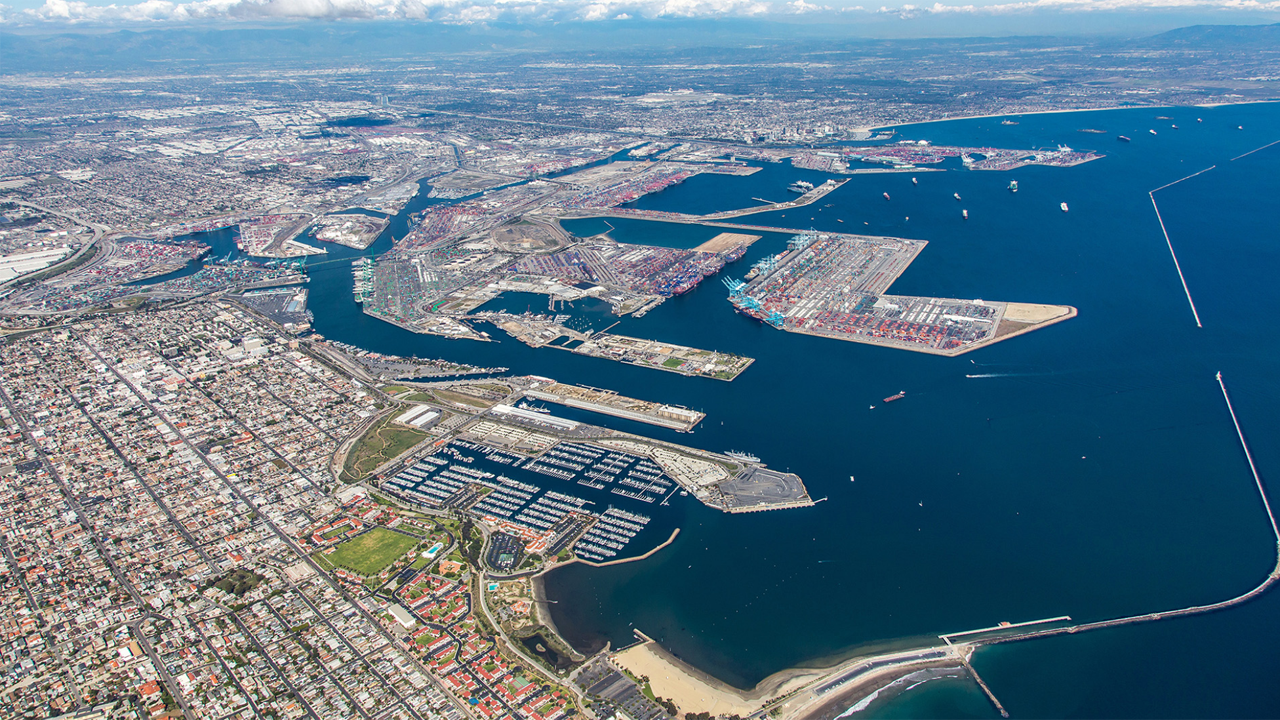
Port of Los Angeles Adopts $2B FY23/24 Budget
Written by Carolina Worrell, Senior Editor
Aerial view of the San Pedro Bay Port Complex in California. (Photograph Courtesy of Port of Los Angeles)
The Los Angeles Board of Harbor Commissioners on June 7 approved a $2 billion Fiscal Year (FY) 2023/24 annual budget for the Port of Los Angeles, calling for “increased investment in Port operational and public-access infrastructure, as well as support for a range of industry leading sustainability and decarbonization initiatives.”
After experiencing sharp declines in cargo volumes in FY 2022/23 due to “inflationary pressures and an overall slowdown in global cargo,” the Port says it forecasts modest gains in the fiscal year starting July 1. As a result, the approved budget predicts a 5.1% year-over-year increase to 8.9 million TEUs (Twenty-Foot Equivalent Units) in FY 2023/24.
According to the Port of Los Angeles, the budget includes total operating revenues of $652.9 million, an 8.6% increase over the FY 2022/23 forecast. Shipping services are expected to make up the bulk of operating revenues at 73.3%, followed by rentals at 15.1%.
Supporting daily operations of the Port, the plan’s FY 2023/24 operating expenses are estimated at $372.4 million. Expenses include funding for supply chain efficiency enhancements; facility and infrastructure maintenance; public safety related to goods movement; property and tenant services and management; cruise center operations; and environmental and sustainability programs, among other activities.
Major environmental and decarbonization projects supported in the plan include the Clean Truck Fund Rate (CTFR) program, created to “incentivize and support cleaner trucks that serve the Port.” The plan also supports a wide range of zero- and near-zero emission equipment demonstration projects currently under way throughout the Port complex.
According to the Port of Los Angeles, the plan’s capital budget totals $252.3 million, a 40.6% increase over the previous fiscal year’s forecast. Funds focus on container and cruise terminal modernization, improving transportation in and out of the Port, and public access infrastructure at the LA Waterfront. Through the Port’s Public Access Investment Plan created in 2015, the Port says it has already invested nearly $253.1 million in public-serving infrastructure improvements. Community projects on tap include the Wilmington Waterfront Promenade, West Harbor in San Pedro, the Front Street Beautification Project, and the Avalon Pedestrian Bridge and Promenade Gateway in Wilmington.
The budget plan is projected to create approximately 4,100 direct and indirect jobs (not including Port employees), of which 3,100 are attributable to capital spending, according to the Port of Los Angeles.
In November 2022, Standards & Poor’s upgraded the Port to an AA+ bond rating with a stable outlook on its outstanding bonds, the highest rating given to a seaport without taxing authority, according to the Port of Los Angeles. Fitch Ratings also reaffirmed the Port’s AA revenue bond rating in March 2023.
“This plan lays out a path forward that strategically balances anticipated cargo revenues with important Port priorities,” said Edward Renwick, Vice President of the Los Angeles Harbor Commission. “By responsibly and prudently managing our budgets during the pandemic and during last year’s global cargo slowdown, we are now in a strong position to continue delivering on critical Port investments and initiatives.”
“While economic uncertainties still linger, this plan will help guide us for whatever might come our way, now and in the future,” said Port of Los Angeles Executive Director Gene Seroka. “Bottom line, our strategic, long-term priorities remain the same: Modernize our physical and digital infrastructure to keep us competitive and invest in community and environmental projects important to our surrounding communities, our region and industry overall.”
In a related development, “the slowdown in International Longshore and Warehouse Union work at West Coast ports has created a congestion contagion that is spreading to the freight railroads, with uncertain consequences for the supply chain,” according to a CNBC report.
According to the report, Union Pacific (UP) announced June 6 that it had temporarily paused all U.S. exports and empty containers to the ports of Los Angeles and Long Beach because of rail congestion. That pause, however, was lifted as of 10 a.m. CT Wednesday, June 7, a UP spokesperson told CNBC.
“We continue to monitor the ports to ensure fluidity,” said the UP spokesperson. “We are presently not seeing an increase in interchanges from other roads (boxes coming into the U.S. from the East), we have not seen that happen yet.”
The average number of trains across UP’s 23-state network is around 600, but the spokesperson stressed, “This is a dynamic and fluid number based on customer needs,” according to the CNBC report.
Meanwhile, BNSF has not issued any embargos and a spokesperson told CNBC that the Class I “at this time plans to keep its gates open.”
Roughly half of U.S. intermodal shipments are related to international trade, so the situation at the ports is “extremely important to railroads,” according to a statement from John T. Gray, Senior Vice President of the Association of American Railroads (AAR), which recently released its latest U.S. rail traffic for the week ending June 3, as well as volumes for May 2023, showing normal freight patterns.
According to the CNBC report, the latest labor issues began last Friday at The Port of Oakland, which was entirely shut down. That port, according to the report, processes less railroad freight compared to the ports of Los Angeles and Long Beach, which have been open with only certain terminals targeted for shutdowns.



